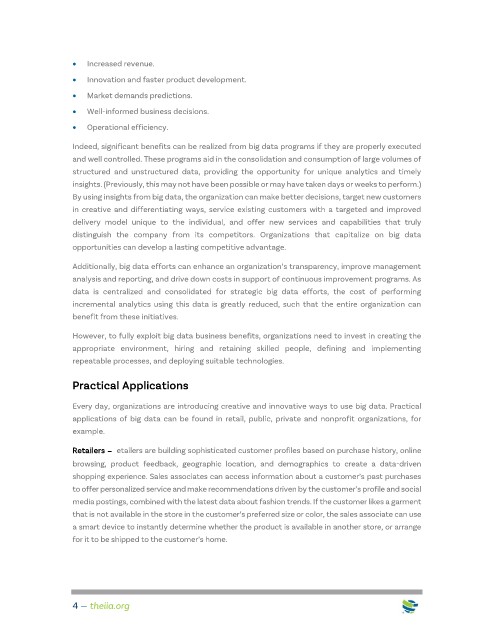Page 423 - ITGC_Audit Guides
P. 423
• Increased revenue.
• Innovation and faster product development.
• Market demands predictions.
• Well-informed business decisions.
• Operational efficiency.
Indeed, significant benefits can be realized from big data programs if they are properly executed
and well controlled. These programs aid in the consolidation and consumption of large volumes of
structured and unstructured data, providing the opportunity for unique analytics and timely
insights. (Previously, this may not have been possible or may have taken days or weeks to perform.)
By using insights from big data, the organization can make better decisions, target new customers
in creative and differentiating ways, service existing customers with a targeted and improved
delivery model unique to the individual, and offer new services and capabilities that truly
distinguish the company from its competitors. Organizations that capitalize on big data
opportunities can develop a lasting competitive advantage.
Additionally, big data efforts can enhance an organization’s transparency, improve management
analysis and reporting, and drive down costs in support of continuous improvement programs. As
data is centralized and consolidated for strategic big data efforts, the cost of performing
incremental analytics using this data is greatly reduced, such that the entire organization can
benefit from these initiatives.
However, to fully exploit big data business benefits, organizations need to invest in creating the
appropriate environment, hiring and retaining skilled people, defining and implementing
repeatable processes, and deploying suitable technologies.
Practical Applications
Every day, organizations are introducing creative and innovative ways to use big data. Practical
applications of big data can be found in retail, public, private and nonprofit organizations, for
example.
Retailers ‒ etailers are building sophisticated customer profiles based on purchase history, online
browsing, product feedback, geographic location, and demographics to create a data-driven
shopping experience. Sales associates can access information about a customer’s past purchases
to offer personalized service and make recommendations driven by the customer’s profile and social
media postings, combined with the latest data about fashion trends. If the customer likes a garment
that is not available in the store in the customer’s preferred size or color, the sales associate can use
a smart device to instantly determine whether the product is available in another store, or arrange
for it to be shipped to the customer’s home.
4 — theiia.org

